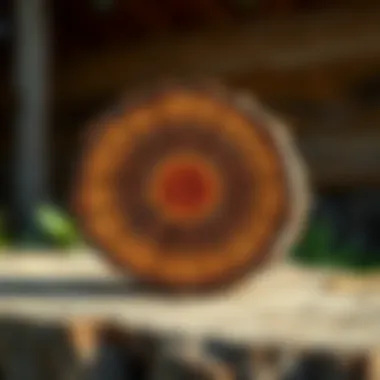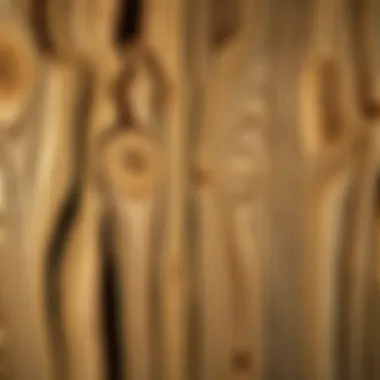Effective Wood Treatment Methods to Prevent Rot


Intro
When it comes to preserving wood, especially in farming and agricultural settings, the prevention of rot is a topic that cannot be ignored. Wood serves an essential role in constructing structures, creating tools, and supporting plants. This article provides an extensive look into treatments that can ward off decay, ensuring wood remains functional and durable over time.
Rot is not merely a nuisance; it's a silent destroyer that can compromise the integrity of wood, leading to costly repairs or replacements. Addressing this issue isn't just a matter of aesthetics; it's also crucial for sustainability and environmental considerations. The following sections will shed light on effective methods to treat wood against rot, explore the history behind these practices, discuss innovative techniques, and provide practical applications that cater specifically to farmers and agricultural enthusiasts.
Intro to Wood Rot
Understanding Wood Rot: Causes and Effects
Wood rot can often arise from one primary culprit: moisture. When wood remains damp, it becomes a veritable buffet for fungi and bacteria which thrive on cellulose. Different species of fungi can cause varying degrees of damage, leading to both soft and dry rot, each with its own characteristics and impact on the wood’s structure.
Common Causes:
- Excessive Moisture: Rain, humidity, or condensation can lead to wood retaining water.
- Poor Ventilation: Areas with stagnant air allow dampness to linger longer than it should.
- Inadequate Treatment: Untreated or poorly treated wood becomes susceptible to decay.
The effects of wood rot are profound: it weakens a structure, compromises safety, and can lead to costly repairs. Symptoms can range from surface discoloration to a spongy texture that indicates a significant ongoing decay process.
Economic Implications of Wood Decay
The costs associated with wood decay can be substantial. First, there’s the price tag of repair or replacement. Structures compromised by wood rot may require extensive renovation or demolition, both time-consuming and costly. The economic implications extend beyond immediate repairs.
- Decreased Property Value: Real estate often loses its value if rot damage is apparent or suspected, which affects seller and buyer negotiations.
- Insurance Considerations: Claims for rot damage can lead to increased premiums or even coverage denial if it’s deemed preventable.
- Loss of Productivity: For farmers, equipment made from wood that decays could lead to operational downtimes, impacting productivity and profits.
In summary, recognizing the importance of wood treatment methods is crucial for mitigating rot, not only to preserve the wood but also to protect one’s investment.
Understanding wood rot isn't just about prevention—it's about safeguarding resources, investments, and the future of farming.
By prioritizing wood treatment, individuals can build a robust foundation against decay, ensuring that their structures stand the test of time.
Biological Mechanisms of Wood Decay
Understanding the biological mechanisms behind wood decay is vital for agricultural farmers and enthusiasts aiming to preserve their structures and materials. Wood, being an organic material, is inherently vulnerable to various microorganisms that can cause significant degradation. By recognizing how and why wood decays, one can implement effective prevention strategies.
The primary agents responsible for wood decay include fungi and bacteria. These organisms break down the cellulose and lignin within the wood, leading to structural weakening. Familiarizing oneself with these mechanisms not only aids in the selection of appropriate treatment methods but also ensures that preventive efforts are aligned with specific threats.
Fungal Decay: Types and Identification
Fungal decay is perhaps the most common culprit in wood rot scenarios. There are three main types of fungi that cause wood decay:
- Brown rot fungi: These fungi primarily degrade cellulose, leaving behind a brownish lignin residue. They give wood a characteristic cubical cracking appearance and are often found in moist environments.
- White rot fungi: These are more versatile, breaking down both cellulose and lignin, leading to a lighter coloration and a spongy texture. White rot is somewhat slower in action, but can devastate wood over time.
- Soft rot fungi: This type is less frequently talked about but still poses a risk. Soft rot usually affects wood that is in contact with the ground, breaking down the wood's structure at a more gradual pace.
Identifying these fungi can help with timely intervention. Farmers and enthusiasts can look for signs such as discoloration, the presence of fungal fruiting bodies, and the texture changes in wood. Regular inspections and familiarity with these characteristics can be lifesavers.
Bacterial Decay: The Lesser-Known Threat
While most people are aware of fungal threats, bacterial decay is often an underestimated issue. Bacteria can contribute to wood breakdown, particularly in damp conditions. Most decay-causing bacteria thrive in areas where moisture is present, breaking down the wood through enzymatic action.
Some key points regarding bacterial decay include:
- Pectinolytic bacteria: These break down pectin, weakening wood cell walls and leading to collapse.
- Cellulolytic bacteria: These specifically target cellulose, turning what was once robust wood into mush over time.
- Environmental conditions: Bacterial action accelerates in warm, humid environments. Understanding these conditions can inform better maintenance strategies.
In recognizing both fungal and bacterial decay, it is clear that vigilance is essential. Applying preventive measures, such as proper treatment techniques and regular inspections, can significantly enhance the longevity of wooden materials. For further information on biological decay mechanisms, consider visiting resources like Britannica and Wikipedia.
Regular inspections and knowledge about decay mechanisms can save a structure from significant damage.
By learning about the specific types of decay and their characteristics, farmers can tailor their wood treatment and preservation strategies to suit particular challenges they may face in their unique environments.
Prevention Techniques: An Overview
In the pursuit of longevity for wood-based products, prevention techniques serve as the first line of defense against rot. It's a bit like having a sturdy umbrella in a rainstorm; while it won’t guarantee that you won't get wet, it significantly reduces your chances. By employing various methods, one can avoid the costly and laborious consequences of wood decay. Understanding what techniques are available can help mitigate risks and extend the lifespan of wooden structures.
Choosing appropriate prevention strategies can dramatically influence both functionality and aesthetics. For farmers and enthusiasts, the right approach contributes not only to structural integrity but also to overall cost efficiency. Preventing rot is not just about keeping your barn or garden furniture intact; it’s about investing in sustainable practices that promote healthier ecosystems.
Choosing the Right Wood Type
Selecting the right type of wood plays a crucial role in prevention efforts. Certain species naturally possess higher resistance to decay and pests than others. For instance, cedar and redwood are often favored in outdoor applications due to their natural oils, which deter moisture absorption and fungal growth.


When considering the choice of wood, one must evaluate specific factors:
- Local Climate: Understanding the environmental conditions is key. Woods that thrive in humid areas may not do well in dry climates.
- Intended Use: Think about what you'll be making. For outdoor benches, select hardwoods that can withstand exposure to elements.
- Cost versus Longevity: Sometimes, spending a bit more on a durable wood can save you money in the long run by reducing maintenance and replacement needs.
In practical application, consider varieties like pressure-treated lumber for projects exposed to moisture. However, keep in mind that treatment methods can affect the wood’s appearance and handling properties, so make an informed choice.
Environmental Factors Contributing to Rot
Discussing the environmental conditions that may lead to wood rot is essential for farmers aiming for effective preservation. The enemy for wood, often lurking unnoticed, can be as straightforward as humidity and poor drainage. To fend off wood rot, consider these elements:
- Moisture Levels: High moisture content is a breeding ground for fungi. Regular checks to ensure proper drainage can help.
- Temperature Fluctuations: Hot and humid conditions can accelerate decay, where constant changes in temperature create additional stress.
- Airflow: Good ventilation around wooden structures aids moisture evaporation, reducing ideal conditions for rot.
To sum up, keeping an eye on these environmental factors can better equip you to take preventive measures. By making small, consistent adjustments, you’ll not only keep your structures intact but also promote a more sustainable approach to wood use.
The path to rot prevention is often paved with simple choices that protect valuable resources, ensuring longevity and sustainability in every piece of wood.
For more information on wood preservation techniques, check out resources from Wikipedia and Britannica.
Natural Wood Treatment Methods
Natural wood treatment methods are essential in preserving the integrity and longevity of wood. Unlike synthetic options, these treatments leverage the natural characteristics of substances derived from plants and other organic sources. This provides a less toxic alternative, making it more appealing for those who are eco-conscious or working within organic farming and gardening principles.
One might consider natural wood treatments as a gentle embrace for the wood, nurturing it from within rather than slapping a harsh chemical coating on its surface. These methods enhance not only the aesthetic appeal of the wood but also its resistance to decay and insect attacks, fostering a healthier environment for plants, animals, and humans alike.
Using Oils and Waxes
When it comes to treating wood, oils and waxes stand out as some of the most effective natural options. Oils such as linseed oil, tung oil, and even coconut oil can penetrate deep into the wood fibers, providing a protective barrier that reduces moisture absorption. This moisture resistance helps to prevent the onset of rot caused by fungi.
The application of oils is straightforward:
- Preparation: Begin by cleaning the wood surface thoroughly to remove any dust or grime.
- Application: Using a brush or cloth, apply the oil generously, ensuring it seeps into every crack and crevice.
- Curing: Allow the oil to cure, which can take several hours to a few days, depending on the type of oil used and environmental conditions.
Waxes can also provide an excellent protective layer. Natural waxes, like beeswax or carnauba wax, add a moisture-resistant finish that not only protects the wood but also enhances its natural grain. It’s worth noting that wax should ideally be used in conjunction with oils for optimal results, forming a robust shield against rot.
"Natural treatments may take longer to show their results, but the long-term benefits far outweigh the initial investment of time and resources."
Herbal and Bio-based Treatments
Diving deeper into the realm of natural treatments, herbal and bio-based solutions are gaining traction. Many plants contain naturally occurring compounds that can be utilized for wood preservation. For instance, extracts from pine, rosemary, and neem are known for their antifungal and antiseptic properties. Utilizing these substances can turn ordinary wood into a fortress against decay.
Considerations when employing herbal treatments include:
- Extraction: Some oils or extracts may require a bit of know-how to extract their active components effectively, ensuring that you’re harnessing their good stuff.
- Application Techniques: These are generally similar to oils but may require additional steps, like boiling or fermenting the plant materials to maximize potency.
- Sustainability: Sourcing materials sustainably is crucial. Many of these plants can be cultivated easily in gardens, ensuring a continuous supply of fresh treatment materials.
The impact of using herbal and bio-based methods extends beyond mere preservation; they reflect a deeper respect for nature and an understanding that protecting one’s materials can also mean protecting the environment. This resonates well with agricultural farmers and garden enthusiasts looking to approach wood treatment from a mindful standpoint.
Chemical Wood Preservatives
Chemical wood preservatives are vital in the fight against wood rot. They provide a protective barrier that extends the life of timber by preventing decay caused by fungi and insects. These preservatives are often the first line of defense for structures like barns, fences, and garden furniture, making their choice an important one for farmers and horticultural enthusiasts alike.
The benefits of chemical wood preservatives are manifold. They offer improved durability, allowing wooden structures to withstand the elements longer, which translates to cost savings over time. When applied correctly, these chemicals can effectively inhibit decay, thereby maintaining the structural integrity of wood installations.
However, their use is not without considerations. Factors such as the chemical composition, application methods, and environmental impact must be thought through. It’s essential to choose products that align with sustainable practices whenever possible.
Common Preservatives and Their Ingredients
Several chemical preservatives are commonly used in the industry. Here are a few notable ones:
- Chromated Copper Arsenate (CCA): Previously popular in residential applications, CCA contains arsenic, which raised health concerns. Its use has decreased due to safety regulations.
- Alkaline Copper Quaternary (ACQ): This is a safer alternative to CCA and is often used in outdoor applications. It helps resist fungal decay and insect attacks.
- Copper Naphthenate: It’s a versatile preservative effective against both wood-destroying fungi and insects. It’s commonly used in agricultural settings where wood is exposed to high moisture.
- Boric Acid: Often used for its fungicides and insecticides properties, this chemical is effective in preventing decay over time and is considered safer for both humans and the environment.
Each of these preservatives can have unique properties and applications, so understanding both their strengths and limitations is key for effective wood protection.
Health and Environmental Considerations
When discussing chemical wood preservatives, it's important to also consider their potential health and environmental impacts. Many preservatives have been scrutinized for their toxicity and long-term implications. For example, exposure to high levels of preservatives like CCA has been linked to health risks, leading to more stringent regulations over the years. It’s crucial for users to follow the manufacturer's guidelines for application and safety measures.
Environmental impact is another significant angle. Some chemicals can leach into the soil and waterways, affecting local ecosystems. Farmers and those in horticulture must weigh the benefits of rot prevention against the potential harm these chemicals can cause in their environment.


To promote safer practices, look for preservatives that are more environmentally friendly or consider integrating natural alternatives where feasible. The balance between effective preservation of wood and keeping soil and water clean is essential for sustainable agriculture and responsible gardening practices.
"Choosing the right wood preservative is not just about preventing rot; it's also about safeguarding your health and the environment."
In wrapping up this section, chemical wood preservatives offer effective solutions to protect timber, but one must consider health and ecological factors before making decisions.
Advanced Techniques for Wood Preservation
The preservation of wood is paramount, especially in agriculture and horticulture contexts. By implementing advanced techniques, not only can wood's lifespan be extended, but its structural integrity can also be maintained even under harsh environmental conditions. These methods include pressure treatment and thermal modification, which present unique advantages and considerations. Understanding how these techniques work can empower individuals to choose the best approach for their specific needs and environments.
Pressure Treatment Methods
Pressure treatment methods involve the use of high-pressure systems to infuse preservatives into the cellular structure of wood. This process is vital because it ensures deeper penetration compared to other treatment techniques, effectively protecting the wood from rot, decay, and insect damage. Common preservatives used in this process include copper-based compounds, which offer long-lasting protection.
The significance of pressure treatment extends beyond mere rot prevention. For instance:
- Extended Lifespan: Properly treated wood can last for decades, making it a cost-effective solution in the long run.
- Environmental Resistance: Treated wood can withstand moisture exposure and environmental extremes that untreated wood cannot.
- Versatility: This method can be applied to various applications, from fence posts to decking.
However, it's essential to be aware of certain considerations:
- Health Safety: Proper handling and safety measures must be followed when working with pressure-treated wood due to the toxic nature of some preservatives.
- Environmental Concerns: With increasing scrutiny on chemical treatments, looking for less harmful alternatives or certified products can be crucial for sustainable practices.
Thermal Modification of Wood
On another front, thermal modification offers an innovative approach to enhancing wood durability. This technique involves heating wood to high temperatures in a controlled environment, altering its properties to improve resistance against decay without the need for chemical additives. The process not only protects wood from rot but also reduces its hygroscopicity, which translates to low moisture absorption.
Benefits of thermal modification include:
- Dimension Stability: Users can observe minimized warping and shrinkage, making the wood ideal for outdoor applications like garden furniture and woodworking.
- Environmentally Friendly: This method uses no harmful chemicals, making it a favorable option for eco-conscious consumers.
- Natural Aesthetics: The thermal process often enhances wood's color and grain, allowing for beautiful natural finishes without synthetic coatings.
Nonetheless, thermal modification is not without its challenges:
- Cost: The setup for thermal treatment facilities can be expensive, possibly leading to higher prices for consumers.
- Limited Availability: This technique may not be as widespread, meaning access to thermally modified wood could be restricted in certain regions.
In summary, both pressure treatment methods and thermal modification present sophisticated options for wood preservation. By weighing the advantages and considering the challenges, farmers and enthusiasts can make informed decisions tailored to their specific requirements. Proper education around these advanced techniques will contribute significantly to sustainable and effective wood treatment practices in various applications.
Practical Applications in Agriculture and Horticulture
In the realm of agriculture and horticulture, the longevity and durability of wooden structures and items are paramount. There’s no room for half-measures when it comes to protecting equipment and facilities from the relentless forces of nature. Practicing proper wood treatment can safeguard investments and ensure that the productivity in any farming or gardening activity is not jeopardized by rot.
Embracing wood preservation techniques not only prolongs the life of essential structures but also enhances the overall aesthetics and functionality of agricultural setups.
Building Structures: Barns and Sheds
Barns and sheds serve as the backbone of many farming operations, housing everything from livestock to equipment. Protecting these structures from rot pays dividends in the long run.
Wooden barns showcased in lush green fields stand as symbols of tradition, but they face threats from moisture and pests alike. When wood is allowed to rot, it can compromise the integrity of the entire structure.
A great many farmers have learned the hard way that putting off proper treatment invites trouble. Letting water get into cracks or crevices is a recipe for disaster. To mitigate these risks, it’s essential to:
- Choose rot-resistant woods like cedar or redwood, which have natural preservatives.
- Apply protective coatings, including stains or sealants, to keep moisture at bay.
- Ensure proper ventilation in structures to promote air circulation and reduce humidity.
Using durable materials also creates a safer environment for animals and stored goods, contributing significantly to the productivity and sustainability of agricultural practices.
Garden Furniture and Fencing Solutions
When it comes to gardens, aesthetics are just as important as functionality. Garden furniture and fencing are not mere accessories; they create environments where plants thrive and families gather. Yet, without proper treatment, wooden fences can become a feast for rot.
Creating a serene garden atmosphere means investing in furniture that withstands the elements. Pieces that are left untreated quickly succumb to mold, pests, and warping, leading to costly replacements.
Consider these tactics for maintaining your outdoor furniture and fencing:
- Use pressure-treated lumber that’s designed specifically for outdoor use, providing an additional layer of defense.
- Regularly inspect for signs of wear or damage, addressing any issues promptly.
- Opt for water-repellent finishes, which can keep surfaces dry in the rainy season.
To put it simply, a well-maintained garden isn’t just about the plants; it’s about a harmonious balance between nature and human craftsmanship. Treating wooden structures and furnishings with care can lead to happier gardens and longer-lasting outdoor spaces.
"Wood treatment isn’t an expense; it’s an investment in the future of your agricultural and horticultural endeavors."


By understanding and implementing effective wood treatment methods, agricultural enthusiasts can carve out vibrant ecosystems, free from the clutches of decay.
Maintenance and Inspection
Maintenance and inspection are critical components in preserving the integrity of wood structures and products. Regular checks not only identify early signs of decay but also prolong the lifespan of the material, ensuring safety and saving costs in the long run. Neglecting this aspect often leads to structural failure, posing risks to both humans and animals, not to mention the ecological footprint that rebuilding or replacing rotted wood lines leaves behind. By adopting a proactive approach, farmers and garden enthusiasts can maintain their wooden assets effectively.
Signs of Wood Rot: What to Look For
Identifying wood rot early can mean the difference between a simple fix and a costly replacement job. Here are some key indicators to watch for:
- Softness: If the wood feels unusually soft or spongy, it’s a clear sign that decay may have set in. This often occurs in areas exposed to moisture.
- Discoloration: Look for darkened patches on the wood surface. This stain usually signifies fungal activity beneath the surface.
- Foul Smell: A musty odor is often an indication of rotting wood, signaling decay caused by bacteria or fungi.
- Mushroom Growth: Fungal growth on the surface is an obvious visual cue. Fungi typically thrive in a damp environment, reinforcing the likelihood of rot.
- Cracking or Splitting: As the rot progresses, wood loses its structural integrity, leading it to crack or split.
It's like having a smoke alarm for your wooden structures; the earlier you catch these signs, the less damage you'll have to deal with later.
Routine Maintenance Strategies
Establishing a regular maintenance routine for wooden structures involves several straightforward practices:
- Regular Inspections: Schedule bi-annual inspections to assess high-risk areas, such as joints, outdoor furniture, and wooden fences. Make this part of your seasonal maintenance schedule.
- Proper Drainage Systems: Ensure that water does not pool around wood structures. Adding drainage channels or simply redirecting water runoff can significantly lower moisture exposure.
- Sealants and Finishes: Use high-quality wood sealers and finishes to create a barrier against moisture. Regularly reapply these solutions, especially after weather events or seasonal changes.
- Ventilation: Improve airflow around wooden structures. Closed, damp environments are conducive to rot; ensuring proper ventilation can help mitigate this risk effectively.
- Cleaning: Regularly eliminate organic debris, like leaves and twigs, that can hold moisture against the wood surface. This simple act can greatly extend wood life.
By integrating these strategies into your routine, you not only extend the life of your wood but save time and money down the line. Remember, it’s all about being proactive versus reactive—stay one step ahead of wood rot.
Future Perspectives on Wood Preservation
The field of wood preservation is evolving rapidly, driven by the push for sustainability and technological advancements. Understanding these future perspectives is crucial, especially for agriculture farmers and enthusiasts who rely on durable wood products. The importance of this topic lies in several key areas such as the incorporation of innovative treatments, sustainable practices, and the integration of circular economy principles.
Addressing wood rot is not merely about applying traditional methods; it's about exploring new frontiers that promise enhanced durability and environmentally friendly options. As climate change continues to alter growth conditions for trees, the wood treatment methods must adapt, ensuring that products remain viable even in challenging environments. This nuanced approach to preservation reflects broader economic and ecological considerations.
Innovations in Natural Wood Treatment
In the realm of natural wood treatment, science and tradition meet to deliver improved options for preserving wood. Innovations in this area focus on extracting beneficial properties from natural resources. For instance, essential oils like tea tree and eucalyptus are being researched not just for their pleasant scents but for their antifungal properties. This opens up avenues for treatments that are both effective against decay and non-toxic to humans and the environment.
Furthermore, advances in bioengineering are leading to the development of hybrid natural preservatives. For example, coatings that combine plant-based resins with herbal extracts could offer a double layer of protection. These methods promise to enhance the durability of wood without contributing to chemical pollution, positioning them as strong contenders in the market.
Additionally, the use of modified starches and cellulose in wood treatments is gaining traction. They can bond with the wood fibers, offering a protective barrier against moisture and microorganisms, thus extending the lifespan of wood products. These innovations not only elevate the standards of wood preservation but also resonate with the eco-conscious demands of today’s market.
Sustainability and Circular Economy in Wood Use
The sustainability of wood protection methods cannot be overstated. As the global community pushes towards greener practices, the circular economy emerges as a fundamental concept in resource management. In the context of wood use, this means not only utilizing sustainably sourced timber but ensuring that treated wood is recyclable or biodegradable at the end of its lifecycle.
Implementing a circular model involves rethinking how wood treatments are created, used, and disposed of. This includes:
- Reducing waste by sourcing materials from reclaimed or recycled wood.
- Encouraging reuse of treated wood in new projects.
- Developing biodegradable treatments, minimizing any potential negative impact on ecosystems.
Moreover, supporting such initiatives cultivates a more sustainable mindset among agriculture communities. Shared knowledge and resources will pave the way for farmers and enthusiasts to adopt best practices, fostering an approach that doesn’t merely focus on preservation but on holistic environmental stewardship.
Ultimately, as the industry strides towards innovative and sustainable wood treatment solutions, it is essential to engage and empower local communities. They are at the crux of utilizing these advancements effectively, creating a ripple effect that goes beyond mere economic gains to foster ecological harmony.
The future of wood preservation lies in the intersection of innovation and sustainability, ensuring that wood remains a viable resource for generations.
As we consider these future directions, it's essential to remain informed and adaptable, always prioritizing methods and solutions that benefit not only the wood industry but also our shared environment.
End
When it comes to long-term wood preservation, understanding the topic of wood treatment strategies is crucial. This article has provided insights into the multifaceted approaches to prevent wood rot through a thorough examination of both traditional and modern methods. By breaking down these strategies, we can not only safeguard our structures and investments but also ensure that our choices resonate with environmental consciousness.
Recap of Effective Wood Treatment Strategies
To summarize, here are key strategies highlighted throughout the article that can help prevent wood from succumbing to decay:
- Choosing the Right Wood Type: Selecting naturally rot-resistant species like cedar or redwood can significantly diminish decay risk.
- Natural Methods: Utilizing oils and waxes, as well as herbal treatments, provides a chemical-free alternative that affirms sustainability.
- Chemical Preservatives: Despite their potential hazards, effective chemical treatments like copper-based formulations can be employed judiciously, with appropriate health precautions.
- Advanced Techniques: Pressure treatment methods and thermal modification offer ways to enhance wood durability without traditional chemicals.
- Routine Maintenance: Regular inspection and maintenance play a vital role in early detection, ensuring any signs of rot are addressed promptly.
These strategies encompass a range of options catering to various needs and preferences, thereby offering both farmers and wood enthusiasts effective routes to preserve their wooden structures and objects.
The Importance of Integraing Knowledge for Long-Term Impact
Emphasizing continual learning and adaptation is pivotal in achieving lasting impact in wood preservation. The knowledge shared here is not merely for immediate application but serves as a framework for future practices.
Understanding the implications of wood treatment not only promotes the longevity of wooden resources but also emphasizes the wider ecological effects of these materials. Farmers and enthusiasts should recognize how sustainable practices benefit both their operations and the environment.
"Knowledge is power; use it wisely to protect what you value."
Learning about effective wood treatments enables stakeholders not only to make savvy choices about materials and methods but also to educate others in their community. As information circulates and awareness grows, a ripple effect can occur, fostering a culture of preservation that extends beyond individual farms or projects.
In this ever-evolving field, staying informed and being open to new techniques will ensure that wood preservation methods continue to meet the demands of contemporary agricultural practices while bearing in mind the principles of ecological stewardship.



